 W
WThe 10th Battalion, Canadian Expeditionary Force was a unit of the First World War Canadian Expeditionary Force (CEF), specifically in the 1st Canadian Division from 1914 to 1919. The battalion participated in every major Canadian battle of the First World War, and set a record for the most decorations earned by a Canadian unit in a single battle at Hill 70. The unit was known to its contemporaries simply as The Fighting Tenth.
 W
WThe American Expeditionary Force, North Russia was a contingent of about 5,000 United States Army troops that landed in Arkhangelsk, Russia as part of the Allied intervention in the Russian Civil War. It fought the Red Army in the surrounding region during the period of September 1918 through to July 1919.
 W
WThe American Expeditionary Force, Siberia was a formation of the United States Army involved in the Russian Civil War in Vladivostok, Russia, after the October Revolution, from 1918 to 1920. The force was part of the larger Allied North Russia Intervention. As a result of this expedition, early relations between the United States and the Soviet Union were poor.
 W
WThe American Expeditionary Forces was a formation of the United States Army on the Western Front of World War I. The AEF was established on July 5, 1917, in France under the command of Gen. John J. Pershing. It fought alongside French Army, British Army, Canadian Army, and Australian Army units against the Imperial German Army. A minority of the AEF troops also fought alongside Italian Army units in that same year against the Austro-Hungarian Army. The AEF helped the French Army on the Western Front during the Aisne Offensive in the summer of 1918, and fought its major actions in the Battle of Saint-Mihiel and the Meuse-Argonne Offensive in the latter part of 1918.
 W
WThe Asia Corps was a detachment of the German Army, sent to assist the Ottoman Army during World War I.
 W
WThe First Australian Imperial Force was the main expeditionary force of the Australian Army during World War I. It was formed as the Australian Imperial Force on 15 August 1914, following Britain's declaration of war on Germany, initially with a strength of one infantry division and one light horse brigade. The infantry division subsequently fought at Gallipoli between April and December 1915, being reinforced by a second division which was later raised, as well as three light horse brigades. After being evacuated to Egypt the AIF was expanded to five infantry divisions, which were committed to the fighting in France and Belgium along the Western Front in March 1916. A sixth infantry division was partially raised in 1917 in the United Kingdom, but was broken up and used as reinforcements following heavy casualties on the Western Front. Meanwhile, two mounted divisions remained in the Middle East to fight against Turkish forces in the Sinai and Palestine.
 W
WThe Second Australian Imperial Force was the name given to the volunteer personnel of the Australian Army in World War II. Under the Defence Act (1903), neither the part-time Militia nor the full-time Permanent Military Force (PMF) could serve outside Australia or its territories unless they volunteered to do so. The Second AIF fought against Nazi Germany, Italy, Vichy France and Japan. After the war, Australia's wartime military structures were demobilised and the 2nd AIF was disbanded, although a small cadre of its personnel became part of the Interim Army that was established in 1947, and from which the Australian Regular Army was formed in 1948.
 W
WThe Australian Naval and Military Expeditionary Force (AN&MEF) was a small volunteer force of approximately 2,000 men, raised in Australia shortly after the outbreak of World War I to seize and destroy German wireless stations in German New Guinea in the south-west Pacific. The German wireless installations were ordered to be destroyed because they were used by Vizeadmiral Maximilian von Spee's East Asia Squadron of the Imperial German Navy, which threatened merchant shipping in the region. Following the capture of German possessions in the region, the AN&MEF provided occupation forces for the duration of the war. New Zealand provided a similar force for the occupation of German Samoa.
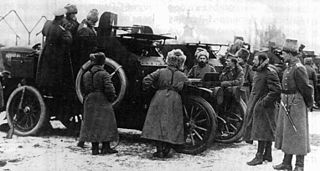 W
WThe Belgian Expeditionary Corps of Armoured Cars in Russia was a Belgian military unit sent to Russia during World War I. It fought alongside the Imperial Russian army on the Eastern Front. Between 1915 and 1918, 444 Belgian soldiers served with the unit of whom 16 were killed in action.
 W
WThe Blue Division was a unit of volunteers from Francoist Spain within the German Army (Wehrmacht) on the Eastern Front during World War II. It was officially designated the Spanish Volunteer Division by the Spanish Army and 250th Infantry Division by the Germans.
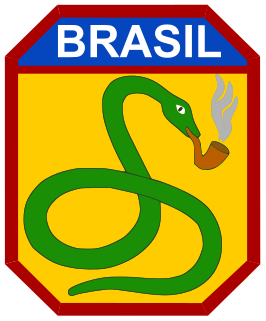 W
WThe Brazilian Expeditionary Force consisted of about 25,900 men arranged by the army and air force to fight alongside the Allied forces in the Mediterranean Theatre of World War II. This air–land force consisted of a complete infantry division, a liaison flight, and a fighter squadron.
 W
WThe British Expedition to Abyssinia was a rescue mission and punitive expedition carried out in 1868 by the armed forces of the British Empire against the Ethiopian Empire. Emperor Tewodros II of Ethiopia, then often referred to by the anglicized name Theodore, imprisoned several missionaries and two representatives of the British government in an attempt to force the British government to comply with his requests for military assistance. The punitive expedition launched by the British in response required the transportation of a sizable military force hundreds of miles across mountainous terrain lacking any road system. The formidable obstacles to the action were overcome by the commander of the expedition, General Sir Robert Napier, who was victorious in every battle against the troops of Tewodros, captured the Ethiopian capital, and rescued all the hostages. The expedition was widely hailed on its return for achieving all its objectives.
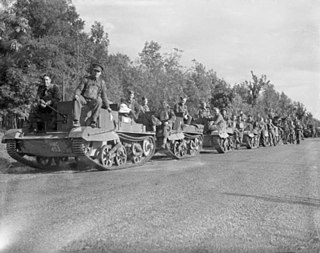 W
WThe British Expeditionary Force (BEF) was the name of the British Army in Western Europe during the Second World War from 2 September 1939 when the BEF GHQ was formed until 31 May 1940, when GHQ closed down. Military forces in Britain were under Home Forces command. During the 1930s, the British government planned to deter war by rearming from the very low level of readiness of the early 30s and abolished the Ten Year Rule. The bulk of the extra money went to the Royal Navy and the Royal Air Force but plans were made to re-equip a small number of Army and Territorial Army divisions for service overseas.
 W
WThe Canadian Expeditionary Force (CEF) was the designation of the field force created by Canada for service overseas in the First World War. The force fielded several combat formations on the Western Front in France and Belgium, the largest of which was the Canadian Corps, consisting of four divisions. The Canadian Cavalry Brigade and the Canadian Independent Force, which were independent of the Canadian Corps, also fought on the Western Front. The CEF also had a large reserve and training organization in England, and a recruiting organization in Canada. In the later stages of the European war, particularly after their success at Vimy Ridge and Passchendaele, the Canadian Corps was regarded by friend and foe alike as one of the most effective Allied military formations on the Western Front. In August 1918, the CEF's Canadian Siberian Expeditionary Force travelled to revolution-torn Russia. It reinforced a garrison resisting Lenin's Bolshevik forces in Vladivostok during the winter of 1918–19. At this time, another force of Canadian soldiers were placed in Archangel, where they fought against Bolsheviks.
 W
WA number of militia artillery batteries were raised in Prince Edward Island from 1875. When the First World War broke out, three battery-sized units were raised and deployed from the Island as part of the Canadian Expeditionary Force.
 W
WThe Chinese Expeditionary Force was an expeditionary unit of the Republic of China's National Revolutionary Army that was dispatched to Burma and India in support of the Allied efforts against the Imperial Japanese Army during the Japanese invasion and occupation of Burma in the South-East Asian theatre of the Second World War.
 W
WThe Combined Joint Expeditionary Force (CJEF) is an Anglo-French military force. It draws upon both the British Armed Forces and the French Armed Forces to field a deployable force with land, air and maritime components together with command and control and supporting logistics. It is distinct from the similarly named UK Joint Expeditionary Force.
 W
WThe Corpo Aereo Italiano, or CAI, was an expeditionary force from the Italian Regia Aeronautica that participated in the Battle of Britain and the Blitz during the final months of 1940 during World War II. The CAI supported the German Air Force (Luftwaffe) and flew against the British Royal Air Force (RAF). The CAI achieved limited success during its brief existence, but it was generally hampered by the inadequacy of its equipment.
 W
WThe Corps of Volunteer Troops was a Fascist Italian expeditionary force which was sent to Spain to support the Nationalist forces under General Francisco Franco against the Spanish Republic during the Spanish Civil War, 1936–39.
 W
WThe Corps Expeditionnaire d'Orient (CEO) was a French Expeditionary Force raised for service during the Gallipoli Campaign in World War I. The corps initially consisted of a single infantry division, but later grew to two divisions. It took part in fighting around Kum Kale, on the Asiatic side of the Dardanelles, at the start of the campaign before being moved to Cape Helles where it fought alongside British formations for the remainder of the campaign. In October 1915, the corps was reduced to one division again and was finally evacuated from the Gallipoli Peninsula in January 1916 when it ceased to exist.
 W
WThe Desert Column was a First World War British Empire army corps which operated in the Sinai and Palestine Campaign from 22 December 1916. The Column was commanded by Lieutenant General Philip W. Chetwode and formed part of Eastern Force. When Chetwode took command of Eastern Force after the Second Battle of Gaza, Harry Chauvel took command and oversaw the expansion of the column to three divisions.
 W
WThe Egyptian Expeditionary Force (EEF) was a British Empire military formation, formed on 10 March 1916 under the command of General Archibald Murray from the Mediterranean Expeditionary Force and the Force in Egypt (1914–15), at the beginning of the Sinai and Palestine Campaign of the First World War.
 W
WThe Eight-Nation Alliance was a multi-national military coalition set up in 1900 to defend legations and Christian missionaries attacked by Chinese Boxer rebels. The forces consisted of approximately 45,000 troops from the eight nations of Germany, Japan, Russia, Britain, France, the United States, Italy and Austria-Hungary. When international legations in Peking were besieged by Boxer rebels supported by the Qing government, the coalition dispatched their armed forces, in the name of humanitarian intervention, to defend their respective nations' citizens, as well as a number of Chinese Christians who had taken shelter in the legations. The incident ended with a coalition victory and the signing of the Boxer Protocol. Members of the alliance remained in China and pillaged Beijing and other cities for over a year.
 W
WThe Force in Egypt was a British Army formation established in August 1914 to administer garrisoning armed forces in Egypt at the beginning of the First World War. The force had the objective of protecting the Suez Canal and was originally commanded by Major General Julian Byng, but he was replaced by General J. Maxwell, who took command on 8 September 1914. Initially, the main threat to the Suez came from Germany and throughout the early months several of the force's elements were sent to Europe to take part in the fighting on the Western Front. On 5 November 1914, Britain and France declared war on the Ottoman Empire, after which the Force in Egypt faced a direct threat from Ottoman forces, which was realised in February 1915 with a raid on the Suez Canal. This threat remained until 1916 when the British forces went on the offensive.
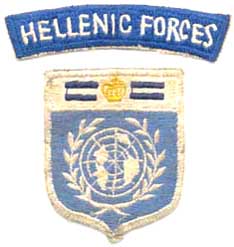 W
WThe Greek Expeditionary Force (GEF) in Korea was formed in response to the United Nations appeal for assistance in the Korean War. It comprised a reinforced Hellenic Army infantry battalion and a Royal Hellenic Air Force (RHAF) flight of seven transport planes. Greece was the fifth largest troop contributor to U.N. Forces in Korea.
 W
WDuring World War II, the Italian Expeditionary Corps in Russia was a corps-sized expeditionary unit of the Regio Esercito that fought on the Eastern Front. In July 1942 the CSIR entered the newly formed Italian Army in Russia as XXXV Army Corps.
 W
WThe Joint Expeditionary Force (Maritime), is the Royal Navy's contribution to the Joint Expeditionary Force (JEF) maintained at very high-readiness and available at short notice to respond to unexpected global events. In addition to the Royal Navy and the Royal Marines, the JEF(M) also includes elements of the British Army and the Royal Air Force. While it is primarily poised to conduct war-fighting or strike operations, the JEF(M) is capable of undertaking a diverse range of activities such as evacuation operations, disaster relief or humanitarian aid.
 W
WThe New Zealand Expeditionary Force (NZEF) was the title of the military forces sent from New Zealand to fight alongside other British Empire and Dominion troops during World War I (1914–1918) and World War II (1939–1945). Ultimately, the NZEF of World War I became known as the First New Zealand Expeditionary Force. The NZEF of World War II was known as the Second New Zealand Expeditionary Force (2NZEF).
 W
WThe (Chinese) People's Volunteer Army was the armed expatriate volunteer forces deployed by the People's Republic of China during the Korean War. Although all units in the PVA were actually transferred from the People's Liberation Army under orders of Mao Zedong, the PVA was separately constituted in order to prevent an official war with the United States. The PVA entered Korea on October 19, 1950, and completely withdrew by October 1958. The nominal commander and political commissar of the PVA was Peng Dehuai before the ceasefire agreement in 1953, although both Chen Geng and Deng Hua served as acting commander and commissar after April 1952 due to Peng's illness. The initial units in the PVA included 38th, 39th, 40th, 42nd, 50th, 66th Corps totalling 250,000 men, and eventually about 3 million Chinese civilian and military personnel served in Korea by July 1953.
 W
WThe Philippine Expeditionary Force to Korea (PEFTOK) was the Philippine Army contingent of the United Nations forces that fought in the Korean War (1950–1953). The unit arrived in Korea in August 1950. It was composed of 1,468 troops, and was the fifth largest force under the United Nations Command. The PEFTOK took part in the Battle of Miudong Battle of Yultong and the Battle of Eeerie Hill. The unit operated alongside the United States 1st Cavalry Division, 3rd Infantry Division, 25th Infantry Division, and 45th Infantry Division.
 W
WThe Portuguese Expeditionary Corps was the main military force from Portugal that fought in the Western Front, during World War I. Portuguese neutrality ended in 1916 after the Portuguese seizure of German merchant ships resulted in the German Empire declaring war on Portugal. The expeditionary force was raised soon after and included around 55,000 soldiers.
 W
WRailway operations were originally established by the United States Army to provide support to France and Great Britain after the United States entered World War I. The Army organized and deployed different types of railway regiments and battalions. As operations progressed, the railway units were used to support the American Expeditionary Forces as well. U.S. rail regiments moved both troops and supplies for the AEF and for the allies from the seaports to the front.
 W
WThe Russian Expeditionary Force was a World War I military force sent to France by the Russian Empire. In 1915 the French requested that Russian troops be sent to fight alongside their own army on the Western Front. Initially they asked for 300,000 men, an unrealistically high figure, probably based on assumptions about Russia's 'unlimited' reserves. General Mikhail Alekseev, the Imperial Chief of Staff, was opposed to sending any Russian troops, although Nicholas II finally agreed to send a unit of brigade strength. The First Russian Special Brigade finally landed at Marseille in April 1916. A Second Special Brigade was also sent to serve alongside other Allied formations on the Salonika Front in northern Greece. In France, the First Brigade participated in the Nivelle Offensive; however with news of the Russian Revolution of 1917 affecting morale within the French Army following the failure of that offensive, the 1st and 3rd Brigades participated in the wave of mutinies spreading across France. The First Brigade was finally disbanded before the end of the year. However, the Honorary Russian Legion of the 1st Moroccan Division continued to maintain a Russian presence in the west and, indeed in the First World War itself, until the Armistice of 11 November 1918.
 W
WThe Honorary Russian Legion was a battalion size group of Russians from the Russian Expeditionary Force in France who continued fighting for the Allied cause in the First World War after the Bolshevik Revolution.
 W
WThe Samoa Expeditionary Force (SEF) was a small volunteer force of approximately 1,400 men raised in New Zealand shortly after the outbreak of World War I to seize and destroy the German wireless station in German Samoa in the south-west Pacific. Britain required the German wireless installations to be destroyed because they were used by Vizeadmiral Maximilian von Spee's East Asia Squadron of the Imperial German Navy, which threatened merchant shipping in the region. Following the capture of German possessions in the region, the SEF provided occupation forces for the duration of the war. Australia provided a similar force for the occupation of German New Guinea.
 W
WThe Services of Supply was the support chain of the American Expeditionary Forces in France, England, Italy and the Netherlands during World War I. It was activated on July 5, 1917 and inactivated on August 31, 1919.
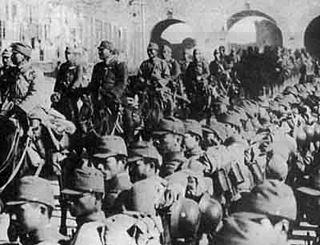 W
WThe Shanghai Expeditionary Army was a corps-level ad hoc Japanese army in the Second Sino-Japanese War.
 W
WThe Siamese Expeditionary Force consisted of the Royal Siamese Army sent to Europe under the command of Major General Phraya Pichai Charnyarit in 1917 to help fight World War I.
 W
WThe Southern Expeditionary Army was an army group of the Imperial Japanese Army during World War II. It was responsible for all military operations in South East Asian and South West Pacific campaigns of World War II. Its military symbol was NA.
 W
WStevedore operations were established by the United States Army to provide movement of supplies through ports in support of the American Expeditionary Forces during World War I. The first American stevedores in France were civilians. Stevedores were originally organized into regiments, and were among the first troops sent to France. Three regiments and two separate battalions were deployed, and were later reorganized into separate battalions and transferred from the Army Service Corps to the Transportation Corps. The battalions were inactivated in France and the troops were assigned to companies without a branch affiliation for their return to the U.S.
 W
WThe Tonkin Expeditionary Corps was an important French military command based in northern Vietnam (Tonkin) from June 1883 to April 1886. The expeditionary corps fought the Tonkin Campaign (1883–86) taking part in campaigns against the Black Flag Army and the Chinese Yunnan and Guangxi Armies during the Sino-French War and the period of undeclared hostilities that preceded it, and in important operations against Vietnamese guerrilla bands during the subsequent 'Pacification of Tonkin'.
 W
WThe UK Joint Expeditionary Force (JEF) is a United Kingdom-led expeditionary force which may consist of, as necessary, Denmark, Finland, Estonia, Latvia, Lithuania, the Netherlands, Sweden and Norway. It is distinct from the similarly named Franco-British Combined Joint Expeditionary Force.